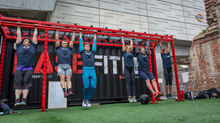3 part Pull up article. Part#1
- Dejan Knespl
- Jan 21, 2016
- 3 min read

Master Pull Ups Part 1: A beginner’s guide.
Part one of a three part series taking a closer look into pull-ups and the techniques you can use to increase your rep range and overall strength.
Look out for the FREE ‘Master Pull-ups in 12 Weeks’ training programme from LetsTrain in part 3!
Pull-ups primarily work the latissimus dorsi, rhomboids and trapezius muscles located in your upper back, with your posterior deltoids (rear shoulder muscles) and biceps assisting as secondary muscles throughout. As there are many different grip widths and hand positions used when discussing pull-ups, for sake of confusion, we’ll be referring to regular pull-ups where your palms are pronated, turned away from your body and hands are slightly wider than shoulder width apart.
The following techniques are tried and tested in improving your pull-up strength and allowing beginners who haven’t yet completed a full rep to get their chin over the bar! If you can’t yet complete a full rep then try including one of these techniques twice weekly at the start of your workout.
Negative reps.
Your muscles can either contract concentrically or eccentrically when in motion. Contractions in which your muscles shorten are called ‘concentric’ while contractions when muscles are lengthening are known as ‘eccentric’.
Studies have shown your muscles can manage up to 75% more resistance eccentrically than they can concentrically which means lifting heavier loads leading to greater muscle growth! For whatever level you are at, negative reps will improve your pull-ups and as a beginner they are vital. The anabolic response from the greater stress placed on your muscles will force growth and improve both the eccentric and concentric parts of the exercise!
Performing a pull-up, our body moves upwards toward the bar concentrically and lowering our body down we move eccentrically, our latissimus dorsi muscles lengthen under tension. Start by using a box or jumping up so you start with your chin over the bar. From here control your body so you lower as slowly as possible until you are in a ‘dead-hang’ position, this means hanging from the bar with your arms fully stretched before repeating the negative rep.
Practising the dead-hang will make it easier to complete reps with a full range of motion (ROM) as you progress.
Start off with 4 sets of 4-8 reps depending on your ability.
Scapula Retraction.
Getting proper scapula activation and retraction is really important if you want to progress to full repetitions. This means the muscles around your scapula (shoulder blades) contract fully and most importantly at the start of each rep. This means from a ‘dead-hang’ position.
Scapula retraction occurs at the very start of the pull-up and this is where most people find they are weakest. Isolating the very first part of the pull-up will help to increase your mobility, the movement starting with arms fully stretched.
Hanging on a bar without swinging, focus on pulling your shoulder blades down and backwards to lift your body an inch or so upwards. In this way you specifically target the lowest part of the move, where your lower trapezius muscles may be weak preventing you from starting from a dead-hang.
Start off with 4 sets of 4-8 reps depending on your ability.
Assisted Reps.
Decreasing the resistance from a full repetition will allow you to steadily build strength until you can complete a rep with no assistance. You can do this a few different ways,
Using an assisted pull-up machine
Using a band – tie the band to the bar and use the soles of your feet to push minimally helping your progress.
Use a box/chair – with a solid base underneath the bar, aim to use one leg to partially assist.
Use a spotter – tuck your legs back so your spotter can hold on to your ankles and ease the ‘pull’ phase of the rep.
“...we are focusing on specifically strengthening the back muscles with good technique...”
To get the best out of assisted reps make sure you only assist as much as is necessary, keep the focus on your upper body, your lower body shouldn’t take over the exercise. Make sure to give directions to your spotter if she/he is helping too much!
Start off with 4 sets of 4-8 reps at the beginning of your workout.
TIP: To get maximum results, always try to control the negative (lowering) phase of the pull-up. This isn’t cross fit training which uses a ‘kipping pull-up’ – here we are focusing on specifically strengthening the back muscles with good technique leading to maximum muscle growth.
Look out for ‘Master Pull Ups Part 2’ where Dejan looks at adding resistance and unilateral training!
Get one of our FREE training plans this winter at www.LetsTrain.info/workouts to help achieve your goals.
Dejan
Instagram @dejanknespl






































Comments